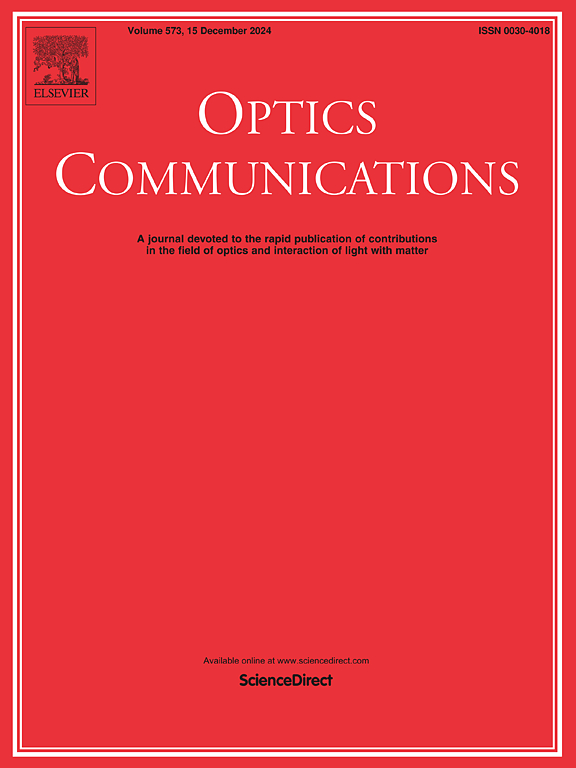KANs-based method for chromatic confocal microscopy
IF 2.2
3区 物理与天体物理
Q2 OPTICS
引用次数: 0
Abstract
Chromatic Confocal Microscopy (CCM) is a highly precise measurement tool that has a wide range of applications. However, traditional CCM data processing methods, such as spectral curve peak extraction and curve fitting, have been observed to introduce errors in the measurement of spectral peak position, fitting parameter values, and data noise. These errors can negatively affect the measurement characteristics of the sensor, including its repeatability and resolution. To address these issues, this study proposes a regression prediction model based on Kolmogorov-Arnold Networks (KANs), which is designed to mitigate the impact of computational errors on the accuracy of CCM measurements. The deep learning model is capable of learning complex non-linear relationships, and inspired by the Kolmogorov-Arnold representation theorem, KANs replace traditional linear weights with spline-parametrized univariate functions, allowing them to learn activation patterns dynamically, thereby circumventing the errors associated with traditional data processing. The experimental results demonstrate that KANs exhibit better performance in CCM relative to one-dimensional convolutional neural networks (1D-CNN) and traditional method. In particular, 1D-CNN demonstrated a 70.0 % enhancement in terms of measurement repeatability in comparison to the traditional method(Gaussian fitting of curves to extract peak and polynomial fitting), whereas KANs method improved by 62.63 % compared to 1D-CNN method. Regarding the axial resolution, KANs demonstrate a 50 nm improvement over traditional methods. Furthermore, the KANs model exhibited a stronger rebuilding capacity in 3D reconstruction. The results demonstrate that the KANs model is capable of markedly enhancing the precision of data processing while preserving the high-resolution attributes inherent to CCMs. This study demonstrates the effectiveness and convenience of KANs model in CCM data processing and shows that the KANs model is effective in maintaining the high-accuracy performance of CCM.
基于kanss的彩色共聚焦显微镜方法
彩色共聚焦显微镜(CCM)是一种高精度的测量工具,具有广泛的应用。然而,传统的CCM数据处理方法,如光谱曲线峰提取和曲线拟合,在光谱峰位置的测量、拟合参数值和数据噪声方面存在误差。这些误差会对传感器的测量特性产生负面影响,包括其可重复性和分辨率。为了解决这些问题,本研究提出了一种基于Kolmogorov-Arnold网络(KANs)的回归预测模型,旨在减轻计算误差对CCM测量精度的影响。深度学习模型能够学习复杂的非线性关系,受Kolmogorov-Arnold表示定理的启发,KANs用样条参数化的单变量函数取代传统的线性权重,使其能够动态学习激活模式,从而避免了与传统数据处理相关的误差。实验结果表明,相对于一维卷积神经网络(1D-CNN)和传统方法,KANs在CCM中表现出更好的性能。特别是,与传统方法(高斯拟合曲线提取峰值和多项式拟合)相比,1D-CNN在测量重复性方面提高了70.0%,而KANs方法比1D-CNN方法提高了62.63%。在轴向分辨率方面,KANs比传统方法提高了50 nm。此外,KANs模型在三维重建中表现出更强的重建能力。结果表明,该模型能够显著提高数据处理的精度,同时保持ccm固有的高分辨率属性。本研究证明了KANs模型在CCM数据处理中的有效性和方便性,表明KANs模型有效地保持了CCM的高精度性能。
本文章由计算机程序翻译,如有差异,请以英文原文为准。
求助全文
约1分钟内获得全文
求助全文
来源期刊

Optics Communications
物理-光学
CiteScore
5.10
自引率
8.30%
发文量
681
审稿时长
38 days
期刊介绍:
Optics Communications invites original and timely contributions containing new results in various fields of optics and photonics. The journal considers theoretical and experimental research in areas ranging from the fundamental properties of light to technological applications. Topics covered include classical and quantum optics, optical physics and light-matter interactions, lasers, imaging, guided-wave optics and optical information processing. Manuscripts should offer clear evidence of novelty and significance. Papers concentrating on mathematical and computational issues, with limited connection to optics, are not suitable for publication in the Journal. Similarly, small technical advances, or papers concerned only with engineering applications or issues of materials science fall outside the journal scope.
 求助内容:
求助内容: 应助结果提醒方式:
应助结果提醒方式:


